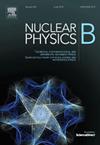用 XMM 望远镜探测超轻原始黑洞暗物质
IF 2.5
3区 物理与天体物理
Q2 PHYSICS, PARTICLES & FIELDS
引用次数: 0
摘要
原始黑洞(PBHs)起源于早期宇宙中大超密度的引力坍缩,在广泛的质量范围内是一种引人注目的暗物质(DM)候选物质。质量在1014克到1017克之间的超轻黑洞尤其引人关注,人们通常通过搜索它们的蒸发产物来探测它们。利用 XMM 望远镜测量到的软 X 射线信号,我们推导出了质量在 1015-1016 g 范围内的 PBHs 暗物质分数的约束条件。我们发现,观测结果排除了质量 MPBH=1015 g 的分数 f>10-6 (95% C.L.)。本文章由计算机程序翻译,如有差异,请以英文原文为准。
Probing ultralight primordial black hole dark matter with XMM telescopes
Primordial black holes (PBHs), originating from the gravitational collapse of large overdensities in the early Universe, emerge as a compelling dark matter (DM) candidate across a broad mass range. Of particular interest are ultra-light PBHs with masses around 1014 to 1017 g, which are typically probed by searching their evaporation products. Using the soft X-ray signal measured by the XMM telescopes, we derive constraints on the fraction of PBHs dark matter with masses in the range 1015-1016 g. We find that observations exclude fraction at 95% C.L. for mass g.
求助全文
通过发布文献求助,成功后即可免费获取论文全文。
去求助
来源期刊

Nuclear Physics B
物理-物理:粒子与场物理
CiteScore
5.50
自引率
7.10%
发文量
302
审稿时长
1 months
期刊介绍:
Nuclear Physics B focuses on the domain of high energy physics, quantum field theory, statistical systems, and mathematical physics, and includes four main sections: high energy physics - phenomenology, high energy physics - theory, high energy physics - experiment, and quantum field theory, statistical systems, and mathematical physics. The emphasis is on original research papers (Frontiers Articles or Full Length Articles), but Review Articles are also welcome.
 求助内容:
求助内容: 应助结果提醒方式:
应助结果提醒方式:


